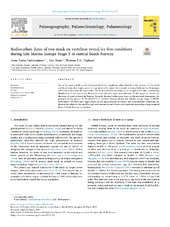Radiocarbon dates of two musk ox vertebrae reveal ice-free conditions during late Marine Isotope Stage 3 in central South Norway
Peer reviewed, Journal article
Published version

Åpne
Permanent lenke
https://hdl.handle.net/1956/23489Utgivelsesdato
2019Metadata
Vis full innførselSamlinger
Originalversjon
https://doi.org/10.1016/j.palaeo.2019.03.032Sammendrag
One of the most reliable proofs of terrestrial ice-free conditions within Stadials is the presence of terrestrial vertebrate fauna that require access to vegetation in the winter, for example sedentary birds such as Ptarmigans and herbivorous mammals in particular. The musk ox (Ovibos moschatus) is an example of the latter; modern-day distributions of this species are limited to areas with low snow accumulations. In this paper we discuss the discovery of musk ox bones in Norway. Recently obtained radiocarbon dates on this material demonstrate the presence of this species 41–35 cal kyr B.P. in southern Norway during late Marine Isotope Stage 3 (MIS3). Furthermore the dates have implications for the interpretation of climate and environmental conditions; indicating the existence of a small ice cap in the mountains and climate and vegetation supporting a large mammal fauna in South Norway at that time.
